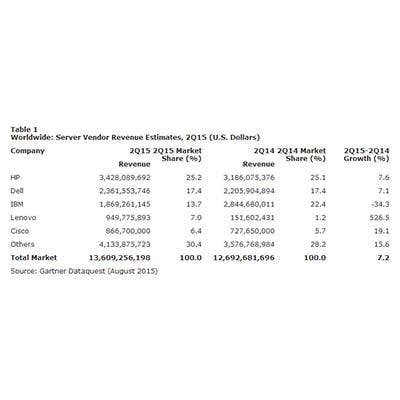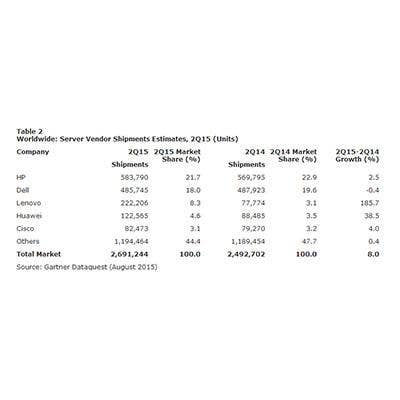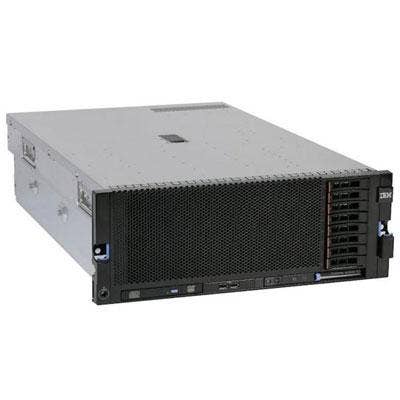Gartner Server Sales Report: Strong Second Quarter Hides Negative Issues

Server Business: Good News, Bad News
Research firm Gartner this week unveiled its second quarter 2015 worldwide server shipments and revenue.
From a quick glance, it looked like a good quarter. Worldwide server revenue reached $13.6 billion, up 7.2 percent from the $12.7 billion Gartner reported for last year's second quarter. Server shipments reached 2.7 million units, up 8 percent compared with the 2.5 million units shipped in last year's comparable quarter.
Jeffrey Hewett, a research vice president at Gartner, told CRN that, while the second quarter server business growth looked good, it compared poorly with first-quarter growth.
But North American solution providers seemed to have fared well. Gartner reported that server shipments in North America rose 14.8 percent, while revenue rose 14.7 percent, the best growth of any region.
Looking for more details? Turn the page and go with CRN through some of the details as well as some of the behind-the-numbers information.

Second Quarter Server Revenue Up
Hewlett-Packard kept its traditional server lead with sales in the second quarter of $3.4 billion, up 7.6 percent over last year's same quarter, Gartner reported. That meant that HP accounted for about one-fourth of the entire planet's server sales.
Dell kept a solid second-place position with sales of $2.4 billion, up 7.1 percent. IBM saw its sales drop more than 34 percent, while Lenovo saw its sales increase more than five times, thanks to Lenovo's acquisition of IBM's x86 server business. Hewitt told CRN that the revenue numbers take into account the server business transfer by comparing sales to last year's sales as if the server deal had already taken place in the second quarter of 2014.

Second Quarter Shipments Up
HP continued its dominance of the worldwide server industry with shipments in the second quarter of 2015 reaching nearly 584,000 units, up 2.5 percent over the same period of last year. That gave HP a market share of 21.7 percent.
Dell kept a comfortable second-place market position in spite of an uncomfortable 0.4 percent drop in server shipments to just under 486,000 units.
Lenovo, thanks to its acquisition of IBM's x86 server business, jumped to third place for the first time with shipments of just over 222,000 units, while its fellow China-based server vendor, Huawei, saw shipments rise 38.5 percent, putting it in fourth place. Cisco rounded out the top five with shipments of more than 82,000 units, up 4 percent.
Hewitt said the big difference between Lenovo and Huawei is that Lenovo, thanks to the ex-IBM x86 server business, sells to customers worldwide, while Huawei's growth came primarily in China.

Behind The IBM, Lenovo Numbers
The growth in the server business of Lenovo, which is using it as part of a bigger enterprise play, hides the fact that sales of x86 servers based on the IBM technology are dropping.
Hewitt said that, when Gartner combines the x86-based server sales from Lenovo and IBM, second quarter 2015 shipments totaled just over 222,000 units, down about 13.8 percent from the second quarter 2014 shipments of nearly 258,000 units.
Revenue during the same period of 2015 reached about $950 million, down 22.3 percent from the $1.223 billion reported in the year-earlier quarter.

B ut All Is Not Well In Server Land
While second quarter 2015 worldwide server revenue rose 7.2 percent and shipments rose 8 percent over last year's same quarter, that can actually be seen as bad news for the server vendors, Hewitt said.
First quarter 2015 server revenue rose 17.9 percent year-over-year, while shipments during that quarter rose 13 percent, he said. The difference is likely due to currency exchange issues, as well as a first-quarter bump in mainframe sales, which might also be currency-related, he said.
"We see certain regional weaknesses," he said. "So we assume some buyers' businesses were affected by the strength of the U.S. dollar. Europe and Japan may have done some buying early in the year, thinking the currency situation will get worse. If that's the case, we'll see a weaker second half 2015."

Average Selling Price Divergence
By comparing the growth in server revenue to the growth in server shipments, one quickly sees that the average selling price for servers grew in the second quarter of 2015 compared with the same period of 2014 for HP, Dell, Lenovo and Cisco. The growth is especially pronounced for Lenovo, which enjoyed the benefit of getting an IBM x86 server line that featured higher prices than its legacy x86 line.
Hewitt said the higher average selling prices did receive a boost in part because of currency fluctuations. "But increased virtualization continues to drive richer server configurations needed to support more virtual machines," he said.
At the other end of the spectrum is the "others" category, which includes not only smaller branded vendors but also the OEM sales to large Web-scale customers. Shipments from "others" rose 15.6 percent in the second quarter over last year, while total revenue rose a measly 0.4 percent, suggesting the commodity servers purchased by Web-scale customers by the container load fell sharply in price.

Different Servers, Different Numbers
Second quarter server shipments and revenue varied wildly in terms of growth, depending on the type of servers tracked.
Gartner reported that, for the second quarter of 2015 compared with the second quarter of 2014:
-- x86-based server shipments rose 8.3 percent while revenue grew 9 percent.
-- RISC/Itanium Unix server shipments fell 18.7 percent, while revenue fell 9.7 percent.
-- Revenue from "other" CPU-based servers, mainly mainframes, rose 7.8 percent.